Where There Is No Silence
Posted on Sept. 12, 2018 | Updated Nov. 27, 2019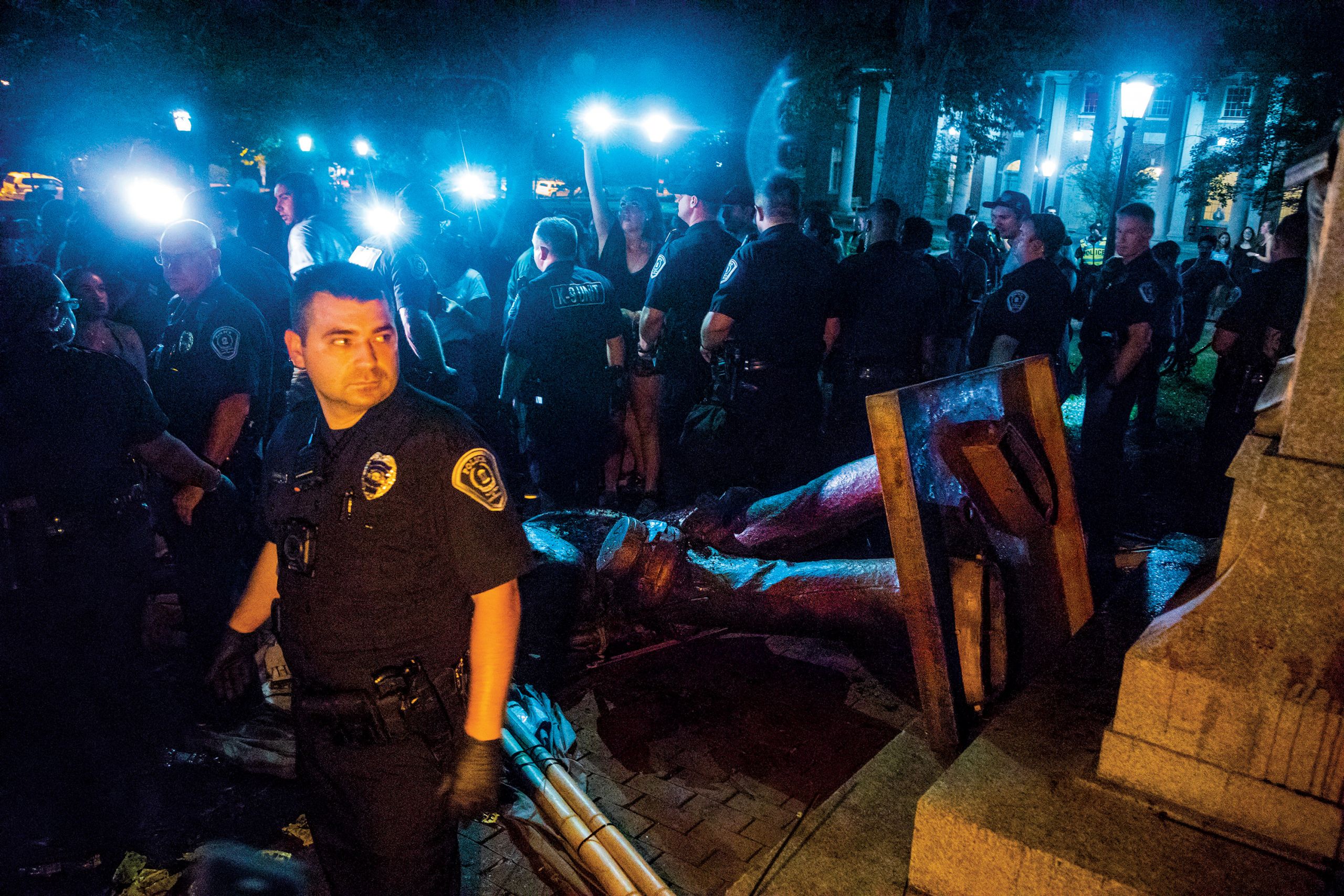
On Aug. 20, the anticipatory eve of the annual start of classes, Chapel Hill and then North Carolina and the nation watched a spectacle that ended with the the Confederate Monument “Silent Sam” face down in the mud. (News & Observer photo)
The Confederate monument is gone, for now, but in safe keeping. As the debate over Silent Sam’s meaning continues, the Board of Governors of the UNC System has told the Chapel Hill campus to find a way to preserve the statue.
by David E. Brown ’75
So many people tried so hard to bring Silent Sam down peaceably.
The rings of young people around the statue, holding banners and chanting — the rallies could be tense, but they were always civil. The packed rooms at town halls and at listening sessions sponsored by the trustees — voices loud, but courtesies kept.
In the end, Silent Sam keeled over in shocking violence. On Aug. 20, the anticipatory eve of the annual start of classes, Chapel Hill and then North Carolina and the nation watched a spectacle that featured the diversion of another mannered demonstration, which gave way to a slow-moving surgical strike on Silent Sam, peppered with anger and shoving in the street at the approach of the denouement.
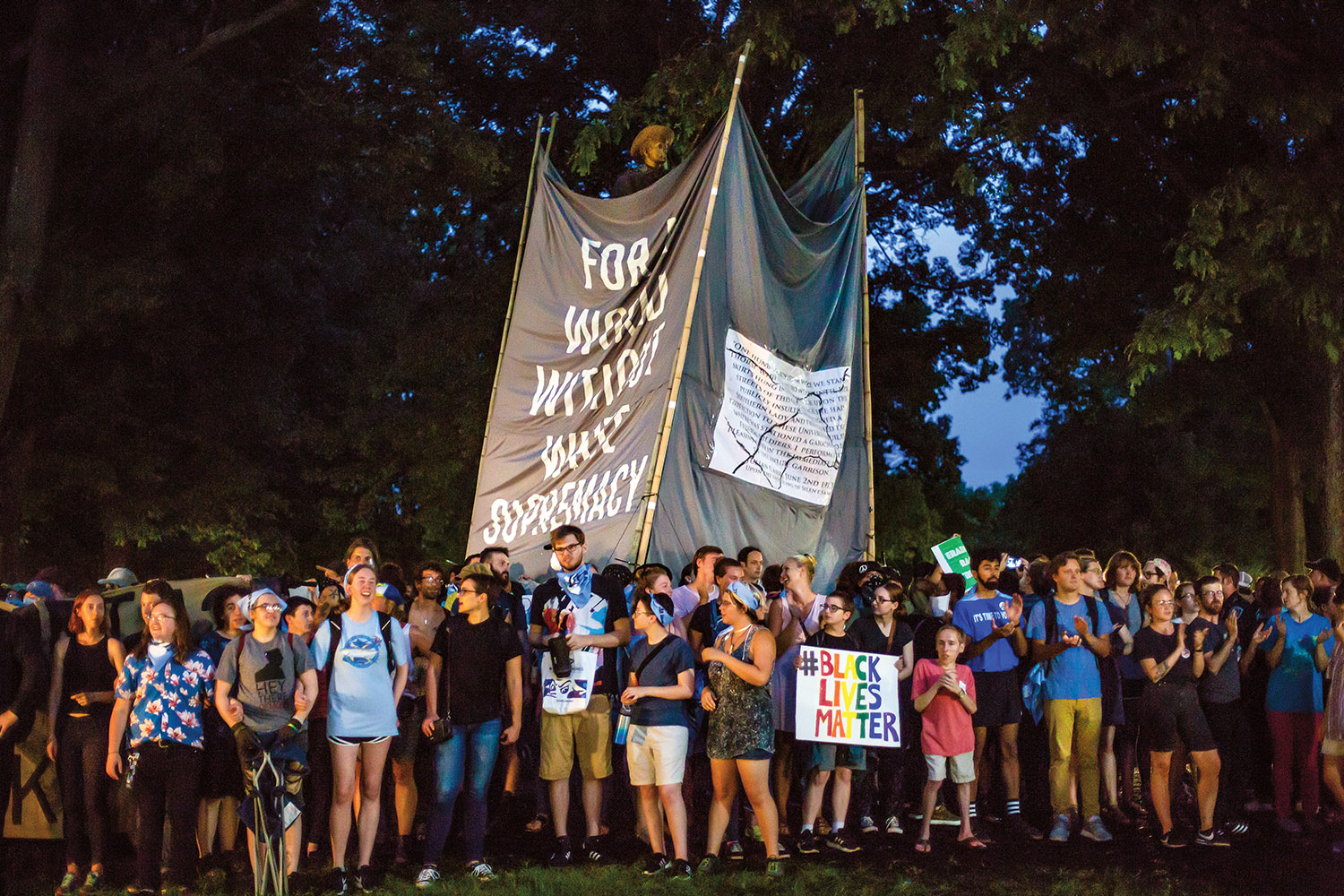
Protesters surround the monument with banners on tall poles on Aug. 20. With Silent Sam shielded from view, others attached ropes with which to pull it to the ground. (News & Observer photo)
Protesters put a rope around the 105-year-old statue — hiding their quick work behind tall banners — and it landed face down in the mud. It was lifted with a front-end loader into a dump truck and taken away in an unceremonious finale.
And what was left behind? So many people satisfied with what they see as a symbolic step toward justice. So many livid in the belief that meaningful symbols have been hijacked, tradition trashed. That deep division was on public display six days later in another loud clash on McCorkle Place — the Confederate flag waved, taunting gave way to physical confrontation. When peace was restored, 14 had been arrested that week; according to police, only one of those arrested was affiliated with the University.
But the state’s top-most higher education leaders had been roused, too.
UNC System President Margaret Spellings and Harry Smith, chair of the system Board of Governors, called the actions that brought down Silent Sam “unacceptable, dangerous and incomprehensible. We are a nation of laws — and mob rule and the intentional destruction of property will not be tolerated.” Chancellor Carol. L. Folt agreed, calling the actions “unlawful and dangerous, and we are very fortunate that no one was injured.”
Much of the public reaction outside Chapel Hill reflected disgust with the scenes of violence and the appearance of anarchy. Social media filled up early Aug. 21 with comments from people favoring either side of the issue.
Folt — supported by Spellings, Smith and UNC trustees Chair Haywood Cochrane Jr. ’70 — said the State Bureau of Investigation would be called in. Smith added that he wanted the BOG to hire an independent firm to study what happened — with an eye toward whether anyone in the UNC administration or campus police gave any orders other than full protection of the statue during the rally.
UNC officials stressed: “Safety is always paramount, but at no time did the administration direct the officers to allow protesters to topple the monument.”

The statue is hoisted into a truck the night it came down. (News & Observer photo)
There also was talk among members of the N.C. General Assembly that the statue should be returned to its pedestal; a state law enacted in 2015 — a particularly active year in issues of race and place — stipulates that any “monument of remembrance” removed temporarily must be replaced within 90 days.
The North Carolina division of Sons of Confederate Veterans sent a letter to Folt demanding that Silent Sam be “put back in its rightful place.”
For a year after the deadly meeting of white supremacists and their detractors in Charlottesville, Va., in August 2017, UNC was prominent among the protests on campuses across the country. Chancellor Carol L. Folt repeatedly stated her preference that the statue be removed, echoing a significant majority of the faculty sentiment.
“That Confederate monument has been a flashpoint and a divisive symbol for decades, and especially since Charlottesville, has been the focus of increasing frustration, anxiety and pain for people,” Folt said three days after it fell. Last November, she said: “If I had the authority, in the interest of public safety, I would remove the monument to a safer location on our campus, where we could preserve, protect and teach from it. What I heard yesterday [when the trustees heard 26 of 28 speakers call for removal] reinforced that belief.”
But UNC officials were up against that 2015 state law that prohibits removal of historic monuments.
A week after the statue was toppled, the trustees and the Board of Governors held separate, simultaneous closed-door meetings. Folt spoke of the “intense emotions,” “the pain, the frustration and anger that’s being felt” as students returned to campus. She added: The “nation’s eyes are upon us.”
The BOG directed Folt and the trustees to find a “lawful and lasting” plan to preserve the monument — with attention to safety — by Nov. 15.
The trustees resolved that the board will respect and enforce the law, do everything possible to ensure a safe campus, honor values of civil discourse and “educate and curate our monuments and our history with integrity.”
The chancellor said she and the board would consider all options for placing the monument on campus in a place of prominence, while ensuring public safety and the preservation of the monument and history.

The crowd at the 1913 dedication of the “Soldier Boy” monument, created by sculptor John Wilson for $7,500. (File photo)
Soldier Boy
“This isn’t the Durham statue, which was an off-the-shelf monument. This was a piece of original casting by a fairly significant foundry.”
Fitzhugh Brundage, immediate past chair of UNC’s history department, wrote a book about the impact of politics on Southern history and how monuments such as Silent Sam often were motivated by resistance to racial equality. The Durham reference was to a Confederate soldier statue that was pulled down by protesters on the county courthouse grounds last year.
“Between 1890 and 1920, there were probably tens or hundreds of monuments being put up every year. So foundries made models of both Confederate and Union soldier memorials, and they had catalogs where you could flip through the pages and see what your community could afford. You’d pick one out, and they’d cast it for you.
“[T]his is a unique monument. It has some historical significance and a certain aesthetic uniqueness … it’s got layers and layers of historical meaning now.”
–Fitzhugh Brundage, immediate past chair of UNC’s history department
“The Durham statue was an off-the-shelf monument. There’s a virtually identical monument from the same foundry in Louisburg. They were a one-size-fits-all memorial.”
Silent Sam, Brundage said, “was a work of original art produced by a sculptor in Boston. It was cast in Rhode Island by a major foundry there. It’s a made-to-order, original piece of art and sculpture. So not only was it more costly to produce it — there was an artist involved — but it was also cast by a foundry that was producing a piece of art for a particular patron. It’s a more substantive piece of work.
“There are some monuments that have local significance, but they aren’t aesthetically unique. But this is a unique monument. It has some historical significance and a certain aesthetic uniqueness.” And “it’s got layers and layers of historical meaning now.”
In 1908, the UNC trustees backed a request from the United Daughters of the Confederacy to put up a statue. President Francis Venable was all for it. He hoped some of the University’s more than 1,000 alumni could attend a grand reunion at the 1911 Commencement. The sculptor, John Wilson, wanted $10,000; he settled for $7,500 — $5,000 from alumni. The “Soldier Boy,” — a 16-year-old Boston lad was its model — finally was ready for a June 1913 dedication.
“I hope, someday, the University will create an actual, dedicated space in which the history of the University is presented, and Silent Sam should be smack-dab in the middle of it,” Brundage said. “You could tell the story of … students participating in the war, you can tell the story of Jim Crow, and you can use the monument as a way to tell the story of student activism.
“It’s a very rich historic artifact. It just should not be a memorial anymore. What is that monument supposed to teach us? What are we supposed to learn?
“This story is far from over.”
Protests become organized
Of the many ways to enter this campus, the most dramatic is to step off the heart of Franklin Street onto McCorkle Place, where the University was born. Silent Sam watched over it; the statue was the first prominent thing you would see.
For decades, it was the butt of a coming-of-age joke — that this inanimate soldier’s gun would fire the moment a virgin walked by. By the mid-20th century, there was a smattering of angst about the implications of so prominent a Confederate monument on a campus known as an intellectual oasis in the South but wracked by its closing at the dawn of Reconstruction and its inability to set itself apart in the Jim Crow era.

Jerry Wilson, a doctoral candidate in education, attended the Aug. 20 rally with a noose around his neck. He read from a letter he’d written to Chancellor Folt: “When you have to take the long way between classes in order to avoid the sight of a statue that denies your human dignity, the Southern Part of Heaven can feel an awful lot like hell.” (Photo by Alex Kormann)
Opposition to the statue remained sporadic, surfacing during extended protests of apartheid in South Africa in the 1980s and in heated arguments surrounding the Center for Black Culture and History in the 1990s.
In 2000, Gerald Horne, an academic and then director of that center, raised eyebrows with a strongly worded call for the statue’s removal, saying that to leave it standing constituted a denial of slavery.
The first student group organized around the issue was the Real Silent Sam Coalition, formed about 2011. The group turned the volume way up in January 2015 in the most dramatic, and angriest, Silent Sam rally up to that time.
A speaker playing the role of Julian S. Carr (class of 1866) repeated portions of the speech Carr gave at the dedication of Silent Sam in 1913, including Carr’s boast that shortly after he returned from service in the Civil War, near the site of the statue, he “horse-whipped a Negro wench until her skirts hung in shreds, because upon the streets of this quiet village she had publicly insulted and maligned a Southern lady.”
Carr was chair of the GAA Board of Directors at the time. The Alumni Review’s account omitted the part of Carr’s speech that was a precursor to periodic protests over the presence of Silent Sam at the center of the oldest part of the campus. Carr went on about “what the Confederate soldier meant to the preservation of the Anglo Saxon race” and declared that the “purest strain of the Anglo Saxon is now found in the 13 Southern states.” His claim of having whipped the woman also was omitted from the Review’s account. For many, Carr’s words were lost to history until about the time the Real Silent Sam Coalition was becoming active; a graduate student discovered them in Carr’s papers.
But in 2015 the coalition had a side issue — a demand that William Saunders (class of 1854), a leader of the Ku Klux Klan in North Carolina, have his name removed from Saunders Hall. In May 2015, the trustees voted 10-3 to change the name; they adopted a generic name, Carolina Hall, and instituted a 16-year moratorium on name changes. It was a turning point in what would be a busy year.
In November, about 300 people gathered at a rally at South Building to hear students’ grievances over what they called the hostile racial environment on the campus. Six days later, in a nearly full Memorial Hall, a group calling themselves “a collective of students who are combatting anti-blackness on this campus” grabbed the spotlight at a two-and-a-half-hour town hall meeting on race, calling for mandatory education on racial sensitivity for everyone on the campus; a voice for students of color in the hiring of top-tier administrators; more aggressive hiring of faculty of color; the hiring of more mental health professionals at UNC with experience specific to the needs of minorities; and disarming and training of campus police in de-escalation techniques.
This momentum spilled over in August 2017 after the white nationalist rally at the University of Virginia. Days later, as Carolina students returned to school, an estimated 800 people encircled Silent Sam — counterprotesters among them. There were no injuries and few arrests in a nearly four-hour rally.
“I do believe that as long as Silent Sam is in its current location,” Folt said in the aftermath, “it runs the risk of continuing to drain energy and goodwill that we worked so hard to maintain on our campus.”
The relationship between the University administration and the UNC System Board of Governors, and between the BOG’s own factions, already was tense on this issue. Fifteen of the 28 BOG members signed a letter expressing their displeasure that Spellings and their chair at the time, Lou Bissette ’68 (JD), did not consult them before asking the governor for help with security on the day before the August 2017 rally. “Wholly unacceptable,” they said.
One thing is clear in the dialogue: The message from some students and other people of color — that they not only lament the weight of a symbol of the Confederacy but feel physically unsafe at times — has not transmitted well outside Chapel Hill.
Meanwhile, monuments related to the Confederacy were coming down all over the country. The Southern Poverty Law Center documented removal of at least 110 “publicly supported Confederate monuments and symbols” since 2015. Flashpoints were the 2015 killing of nine African-Americans in a church in Charleston, S.C., and the Charlottesville saga.
A couple of lawsuits to force removal of Silent Sam were threatened; a legislative bill was filed to move the monument to an indoor location. The administration reported in July that it had spent $390,000 on 24/7 police security in the area around the statue in a year.
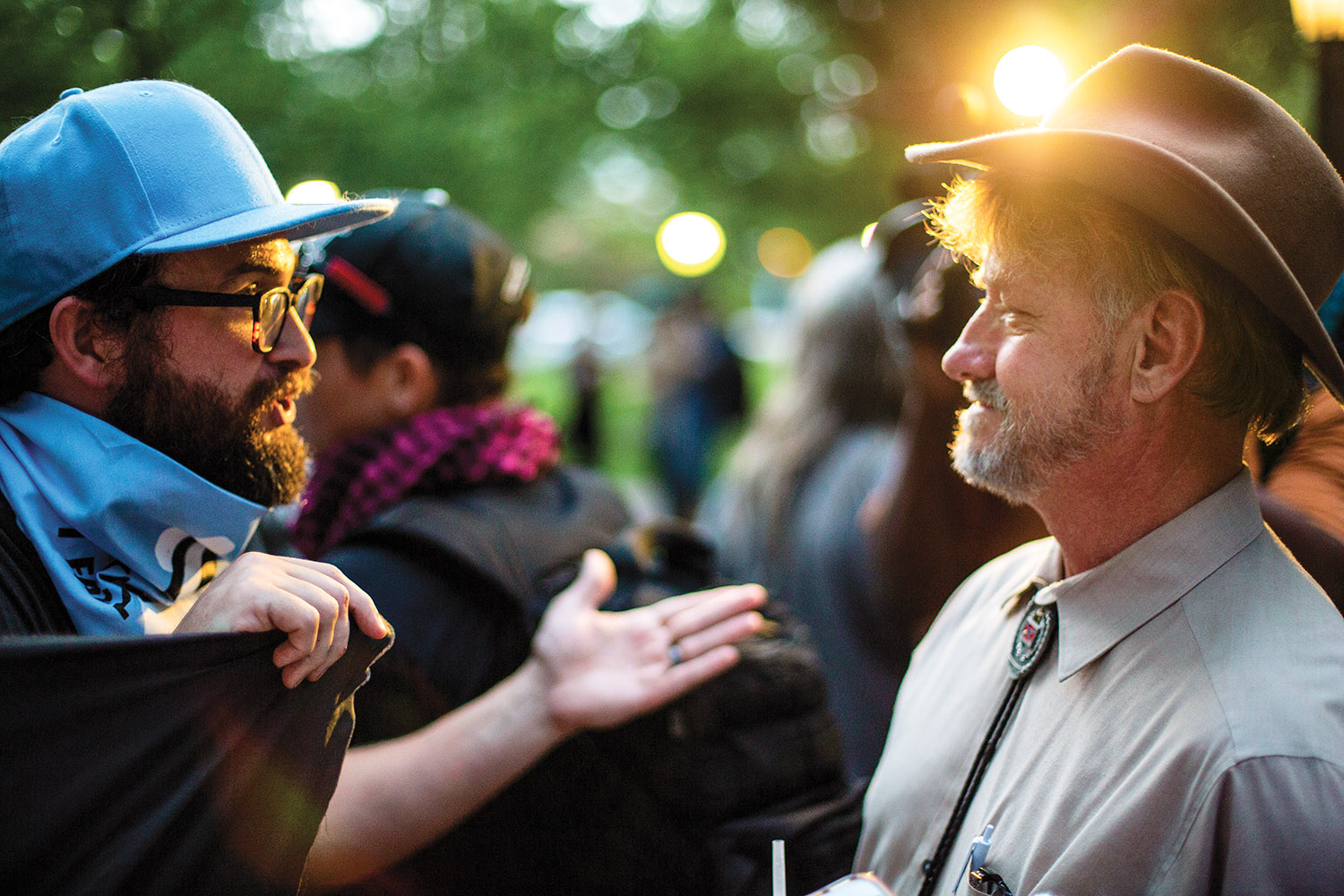
Individual confrontations over the Silent Sam issue became commonplace at rallies. (Photo by Alex Kormann)
One thing is clear in the dialogue: The message from some students and other people of color — that they not only lament the weight of a symbol of the Confederacy but feel physically unsafe at times — has not transmitted well outside Chapel Hill.
“I stand at the statue almost every day and give information about it to passersby,” Maya Little, a doctoral candidate in history, told the trustees last November. “I see this as a part of my duty here as a history student and teacher. … It is a public safety hazard. White supremacists, some of them Carolina fans and alumni, tell us we need to stop talking about racism. They tell us we need to be put back in our place. … They tell us that they will bring their guns. … They tell us that they will end us. That they will kill us.”
Last fall, football game days were occasions for protesters to be accosted by visitors, those keeping vigil at Silent Sam said.
Little, a longtime leader of the Real Silent Sam Coalition that pushed for the removal of the statue and for the renaming of Saunders Hall, boiled over in May, dumping red ink and what she said was her own blood on the monument in full view of the police. She faces charges in that incident.
Another alumnus said recently that when he was in Chapel Hill in the 1980s, Sam was the virginity joke and nothing more — but that when he’s on campus these days, given the opening of the dialogue, the statue makes him think about the way his forebears, who were white, subjugated another race and the way they were used as cannon fodder for the captains of an economy based on slave labor.
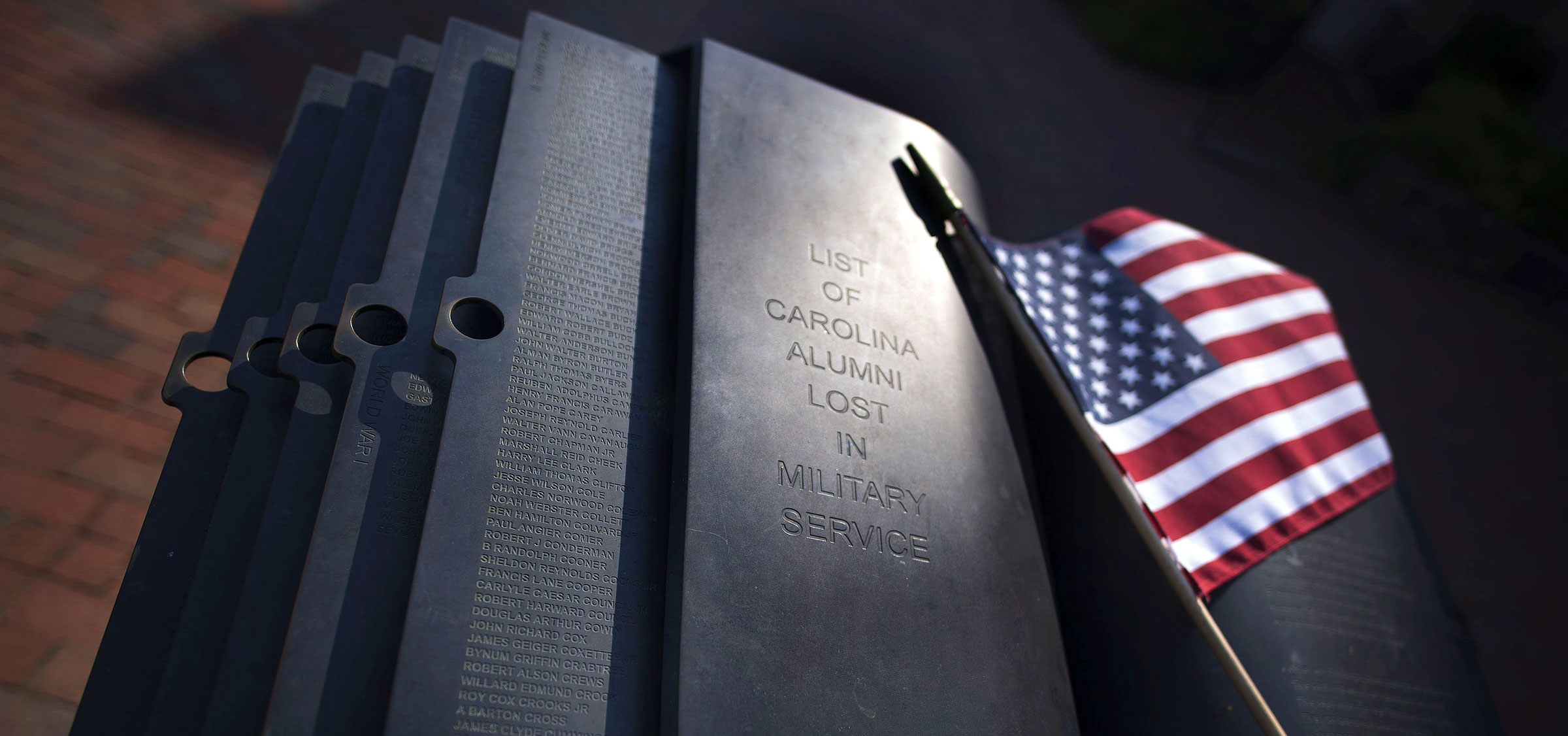
Carolina Alumni Memorial in Memory of Those Lost in Military Service. (UNC photo by Jon Gardiner ’98)
Nearby, a War Memorial to All Who Died
It was a small point of confusion probably as long as Silent Sam stood: Does that monument represent alumni who gave their lives in the Civil War or all who served? The correct answer is the latter.
But there is a campus monument to those who died in that regional conflict and in military service since the War of 1812. It’s never been controversial.
The Carolina Alumni Memorial in Memory of Those Lost in Military Service, in an open space on Cameron Avenue between Phillips and Memorial halls, was dedicated in April 2007. The memorial’s bronze Book of Names includes pull-out panels listing names of alumni who lost their lives in battle and in training accidents during time of war. They are grouped alphabetically by conflict.
The GAA’s Records Department began work on this project in 2002. GAA records show that 287 alumni died fighting in the Civil War, all in Confederate forces.
The idea for the Book of Names memorial originated with Chapel Hill businessman Robert W. Eaves ’58, who was inspired by a visit to the American cemetery in Normandy to lead an effort for an additional memorial to Carolina’s war dead. Eaves and fellow ROTC Carolina alumni Sherwood H. Smith Jr. ’56 and Charles M. Winston Sr. ’53 of Raleigh headed a committee that raised $300,000, mostly from ROTC alumni.
The Book of Names is flanked by an unassuming series of low stone walls, fronted by a long, slightly higher sandstone slab. On the reverse side, above a sandstone bench, are words of Thomas Wolfe ’20 from Look Homeward, Angel: “He heard … the mellow booming of the campus bell. And suddenly it seemed to him that all the beaten walks were thudding with the footfalls of lost boys, himself among them, running for their classes. Then, as he listened, the far bell died away, and the phantom runners thudded into oblivion.”
A sidewalk bisecting the rock walls is engraved with quotations from soldiers and sailors from eight wars.
Carolina has a long history of honoring the lives of its alumni and others who lost their lives in battle. In 1883, when the University needed more space for Commencement than Gerrard Hall could provide, a larger building was built nearby that was meant to serve as a memorial to David Lowry Swain — a past president of the University — to other notable North Carolinians, and to alumni, students, faculty and staff who died in the line of duty. The marble tablets commemorating those first individuals so honored were installed when Memorial was dedicated in 1885.
In 1931, a new Memorial Hall was built, and the marble tablets were retained then and during a later major renovation to the hall in 2002 through 2005. Prominent in the lobby are these words of dedication: “Memorial Hall was erected as a memorial to President Swain as well as to all others connected with the University, who, by honorable lives in civil or military service, deserve commemoration here.”
The name of UNC’s original hospital, N.C. Memorial, honors North Carolinians who died while serving in the U.S. armed forces. The 1952 dedication plaque in N.C. Memorial’s lobby reads: “To serve as a continuing memorial to those who have given their lives, and who may hereafter give their lives, as members of the armed forces in protecting the freedom and common welfare of their fellow citizens.”
In 2010, an online edition of this memorial became available, including a biographical page for each alumnus listed, along with a tool to search by conflict. That information, based on the GAA’s Records Department’s work, was assembled and edited by members of the Carolina Alumni Review staff Anyone who believes a friend’s or a relative’s name should be added to the Book of Names should contact the GAA’s Records Department: alumni@unc.edu.
Where to now?
Carolina’s campus is not big on monuments. They’re placed sparingly. The University accepted an idea from the class of 2002 to place another sculpture in McCorkle Place, to the southeast of Silent Sam near the Graham Memorial and Alumni Building.
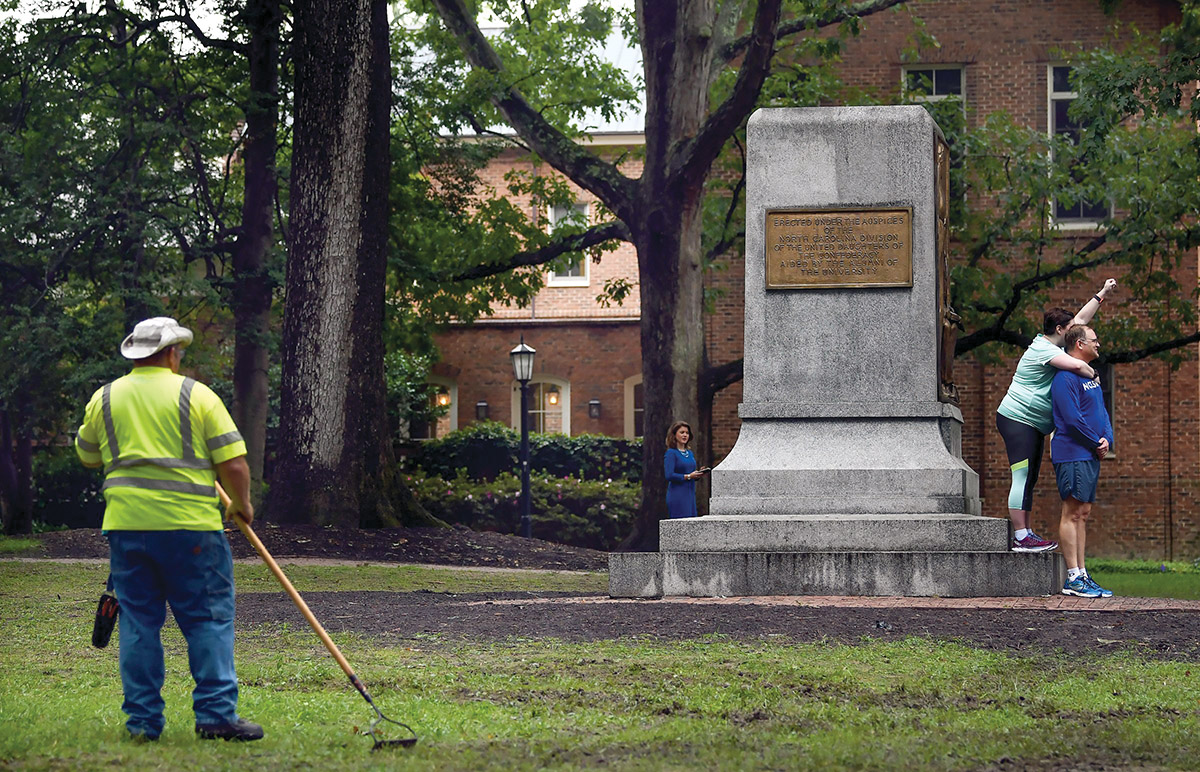
McCorkle Place passers-by pose with the bare pedestal that remains. (News & Observer photo)
The Unsung Founders Memorial is dedicated to “The People of Color Bond and Free Who Helped Build the Carolina That We Cherish Today.”
Many of the people who wanted Silent Sam removed have a complaint about that memorial, too: Its size, a few feet off the ground, makes it easy to overlook; people sit around it and eat their lunches, change their babies’ diapers. (It includes marble seats, leaving the impression it was designed as a welcoming table.)
UNC plans re-landscaping around it to enhance its prominence and explain its purpose beneath McCorkle’s tree canopy.
Of many questions yet to be answered, a key one is: How, here in the oldest quad, will the University face and convey its racial history?
The trustees addressed that when they took down Saunders’ name — a large display opened in that building’s lobby in short order.
More than three years have passed with no ground broken since the trustees ordered hard-to-miss historical signage in McCorkle. In fall 2015, a task force heralded “a mix of physical and virtual interpretations and, possibly, new temporary and permanent art projects” that could go back as far as the impact on the area of native peoples before European colonization and continue through the slavery story, Reconstruction, Jim Crow and beyond. The trustees set no deadline.
Now, the Board of Governors has set one for the future of Silent Sam.
David E. Brown ’75 is senior associate editor of the Review. Eric Johnson ’08 contributed to this report.
Timeline: Silent Sam and Related Issues
Calls for removal of the statue — and rallies for its support — have occurred periodically for decades.
1908 Trustees approve erection of a monument by the United Daughters of the Confederacy in memory of UNC students who joined the Civil War effort. 1913 Dedication of what was then called the Soldiers’ monument includes a speech by Confederate veteran, trustee and industrialist Julian S. Carr (class of 1866) that includes an account of having “horse-whipped a negro wench” near the site, because “she had publicly insulted and maligned a Southern lady.” 1954 Apparently first use of the name Silent Sam, in The Daily Tar Heel, due to the fact the soldier carried no ammunition. 1965 A letter appears in The DTH that asks whether the statue is a racist symbol that should be removed. 1968 Graffiti appears on Silent Sam at the time of Martin Luther King Jr.’s assassination. 1971 and again in 1973, UNC’s Black Student Movement holds protests at the statue after the deaths of black men killed by a motorcycle gang and by police. 1992 Silent Sam is the site chosen for Chancellor Paul Hardin and others to speak to students about the controversial beating of Rodney King by the Los Angeles police and the issue of whether UNC should erect a freestanding Black Cultural Center. 2000 February: Gerald Horne, then director of UNC’s Black Cultural Center, writes a newspaper column in which he likens the statue to a Confederate battle flag and says it was hypocrisy and slavery denial for UNC to leave it standing. 2011 September: Members of the Real Silent Sam Coalition hold a protest at the statue, calling it offensive and suggesting UNC erect a reinterpretation plaque to explain it. 2015 January: Students lead a large, angry rally around Silent Sam, demand the renaming of Saunders Hall for author and activist Zora Neale Hurston. April: UNC trustees hold a special meeting to hear comments on the name-change issue. May: Trustees vote 10-3 to change Saunders to Carolina Hall, approve a 16-year moratorium on other renamings and order “curating” of UNC’s racial history. July: Vandals deface Silent Sam, painting “KKK” and “murderer.” N.C. General Assembly enacts a law prohibiting removal of any publicly sited “monument of remembrance.” September: Chancellor Carol L. Folt announces a task force to carry out the trustees’ directives. November: Students of color speak out at a large rally outside South Building in the aftermath of racial unrest at the University of Missouri; a week later, a town hall meeting fills Memorial Hall, where students present a long list of demands. 2016 January: Chancellor Folt meets with leaders of the movement, who amplify demands; later she reports to the campus on required racial sensitivity training for administrators and a dedicated gathering place for black students, and she promises results of a survey on diversity. November: Carolina Hall lobby display is unveiled. 2017 August: UNC Police erect two concentric circles of steel barricades around Silent Sam in anticipation of a protest rally that evening, amid talk that the statue might be taken down. Gov. Roy Cooper ’79 (’82 JD) tells UNC officials they can take it down in the event of an imminent threat to public safety and security. UNC attorneys decide not to challenge the law. November: Trustees hold a listening session on Silent Sam — 28 people speak, two of whom support keeping the statue. Folt says: “I’d like to reiterate that, if I had the authority, in the interest of public safety, I would remove the monument to a safer location on our campus, where we could preserve, protect and teach from it. What I heard yesterday reinforced that belief.” A campus police officer goes undercover at the statue to engage both sides in conversation. 2018 May: Graduate student Maya Little throws red ink and what she says was her own blood on Silent Sam in full view of the police assigned to protect it and is arrested. July: UNC reports it spent about $390,000 to provide police security for Silent Sam, July 2017 through June 2018. Aug. 20: A Franklin Street protest is a diversion for an organized offensive on the statue, and protesters pull it off its pedestal, igniting a response marked by jubilation and by angry street confrontations. Aug. 25: A group of Confederate monument supporters clashes just off Franklin Street with those supporting removal. Aug. 28: Board of Governors passes a resolution directing Folt and the trustees to come up with a “lawful and lasting” plan to preserve the monument with attention to safety, and it sets a Nov. 15 deadline. Aug. 31: As of this date, a total of 17 people had been arrested related to three protest events; of those, 16 were not affiliated with the University. December: UNC announces it will ask for the Board of Governors’ approval to build a $5.3 million Center for History and Education, where Silent Sam would be on display indoors. In mid-month, the Board of Governors rejected that proposal and set up a five-member task force of its members to work with trustees, the chancellor and UNC’s top administrative staff to come up with another plan for Silent Sam by March 15. 2019 March: BOG extends the deadline to May. April: BOG Chair Harry Smith tells a news conference he thinks restoring Silent Sam to its original site is “not the right path,” a reversal of Smith’s previous stance. May: Indefinite delay announced for the disposition decision. November: The statue is given to the Sons of Confederate Veterans in an agreement approved by the Board of Governors.
Thanks for reading the Carolina Alumni Review
Carolina Alumni members, sign in to continue reading.
Not yet a member? Become one today.
